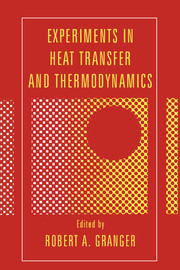Book contents
- Frontmatter
- Contents
- Preface
- Introduction
- Part I Experiments in heat transfer
- I.1 Conduction
- I.2 Convection
- I.3 Boiling
- I.4 Mixing, dispersion, and diffusion
- I.5 Radiation
- I.6 Heat pipes and exchangers
- Experiment 24 Performance characteristics of an annular heat pipe
- Experiment 25 Heat transfer during drop formation and release
- Part II Experiments in thermodynamics
- Appendix 1 Experiments and demonstrations in thermodynamics
- Appendix 2 Experiments and demonstrations in heat transfer
- Appendix 3 Heat-transfer and thermodynamic films
- Index
Experiment 24 - Performance characteristics of an annular heat pipe
Published online by Cambridge University Press: 05 June 2012
- Frontmatter
- Contents
- Preface
- Introduction
- Part I Experiments in heat transfer
- I.1 Conduction
- I.2 Convection
- I.3 Boiling
- I.4 Mixing, dispersion, and diffusion
- I.5 Radiation
- I.6 Heat pipes and exchangers
- Experiment 24 Performance characteristics of an annular heat pipe
- Experiment 25 Heat transfer during drop formation and release
- Part II Experiments in thermodynamics
- Appendix 1 Experiments and demonstrations in thermodynamics
- Appendix 2 Experiments and demonstrations in heat transfer
- Appendix 3 Heat-transfer and thermodynamic films
- Index
Summary
Principle
The annular heat-pipe design can significantly increase the heat capacity per unit length compared to conventional cylindrical heat pipes due to the capillary forces generated in the wick material on the inner pipe.
Object
The primary objective of this experiment is to compare the maximum heat transport (capillary) limit of the annular heat pipe to that of a conventional cylindrical heat pipe with the same outer diameter and wick structure. A secondary objective is to examine the temperature distributions on the inside and the outside of the annular heat pipe. Finally, the problem of condensate leakage between the inner wick and the outer wick will be addressed.
Apparatus
The annular heat pipe, as shown in Fig. 24.1, consists of two concentric pipes of unequal diameters attached by means of end caps, which create an annular vapor space between the two pipes. Wick structures are placed on both the inner surface of the outer pipe and the outer surface of the inner pipe (Fig. 24.2). Axial grooves were chosen in this experiment since no special procedures are needed for installation, but any type of wick can be used. The space inside the inner pipe is open to the surroundings. An increase in performance is expected as a result of the increase in surface area exposed for the transfer of heat into and out of the pipe, and the increase in the cross-sectional area of the wick inside the pipe.
- Type
- Chapter
- Information
- Experiments in Heat Transfer and Thermodynamics , pp. 181 - 191Publisher: Cambridge University PressPrint publication year: 1994



